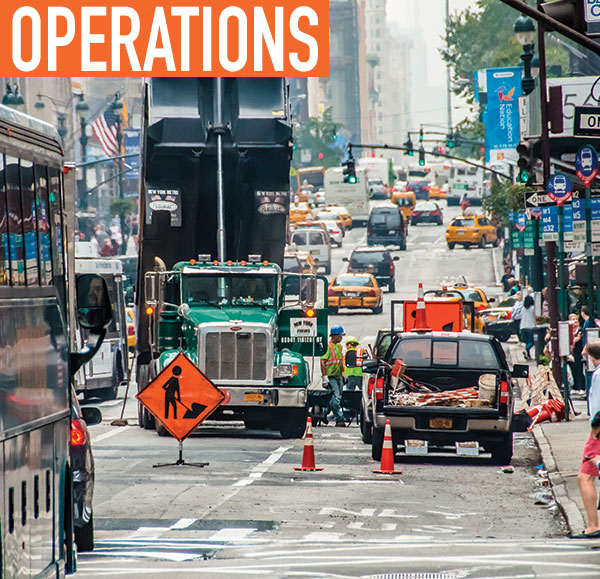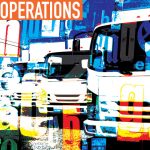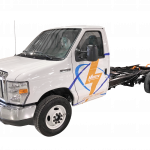Fleet managers and procurement teams are charged with designing reliable, functional work trucks capable of undergoing the stresses of the vocational market and occupational work environment. No matter what your role on the design team (specification writer, supplier, upfitter, or final decision-maker), it is imperative to understand the work mission of these specialized vehicles.
What defines a work mission? It starts with supporting an organization’s mission statement and directly influences operations at the fleet level. The work mission involves providing the right tools that maximize efficiency and reliability, while operating in extreme duty cycles and environmental conditions. Before anyone in the industry can design vehicles to outlast the rigors of the work environment, the first step is gaining full awareness of mission requirements and available alternatives. Examples include operator feedback, geographic location of the truck, fuel type/availability, and payload requirements.

COUNT THE COST
When designing and purchasing vocational vehicles, there are several options available in both procurement and design aspects. The route a fleet professional chooses can directly influence overall unit cost. With some solid data collection, historical information can become a great source of insight when looking for ways to control cost.
In addition, it’s necessary to know that cost control includes components that are both direct (acquisition, operating, and maintenance) and indirect (temporary replacement vehicles and underused operator resources). Reliability and use are some of the most critical aspects of cost control. Vehicles that are underused are not necessarily unneeded, but it is essential for the fleet operator/owner to be able to make a clear value assessment.
In terms of reliability, consider whether the vehicle is properly designed to survive the rigors of the work mission from the start. Reliability is a critical aspect of all fleet-related activities. Unavailable tools lead to fleet ineffectiveness, including loss of productivity and, in some cases, direct company revenue. Even still, reliability can be the focal point of cost control for fleet operations. Minimizing out-of-service events can ensure a fleet is more reliable and augment effectiveness of field personnel. Having a more reliable fleet translates into fewer vehicles needed to fulfill operations, allowing you to examine and fine-tune asset use.
DRIVE AND DUTY CYCLE
Drive and duty cycle go hand in hand when designing work trucks. Drive cycles provide data on how vehicles are used. These data points include maximum/average speed, idle time, engine off time, and power export time. Duty cycles give fleet managers insight into how much (as opposed to how) a vehicle is being, including information like days per week or measurement cycle of use, hours per shift/day, total distance traveled, and engine load profiles. Evaluating both of these data clusters while interacting with the operational environment is key.
The operational environment encompasses geographic areas—either local, regional, or large territories. Weather conditions can influence vehicle design: Are your vehicles operating in snowy or salty regions that require corrosion protection? Are they functioning in mountainous areas that demand starting gradeability and present powertrain concerns? Identifying your fleet’s operating needs and communicating with the stakeholders involved in your vehicle design are significant priorities.
Once properly designed, standardizing your vehicles can support reliability. Having standardized vehicles makes it easier to stock replacement parts, develop well-trained maintenance crews, and create safe and effective upkeep routines. Having several one-offs or different standards may be a way to reduce initial acquisition cost but ultimately increases maintenance expenses and potentially extends downtime.
REGULATIONS AND SAFETY
Conforming to regulations is nonnegotiable when designing vehicles. However, requirements are constantly changing, and it can be challenging for fleet managers to keep up with the latest rules, which often evolve based on experience. For example, prior to the year 2001, no states had regulations geared toward talking on mobile devices while operating motor vehicles. Data shows cellular activities increase driver distraction, and operators are currently advised to avoid using these devices while underway.
Another more recent regulation was enacted to improve rearview visibility. Full FMVSS 111 rear visibility conformance in the US—which includes requirements for field of view, image size, response time, deactivation, durability, default view, and linger time—took effect May 1, 2018. This requirement is applicable to vehicles with a 10,000-lb gross vehicle weight rating or less.

Using multiple resources to ensure your designs meet conformance standards is an essential step in the vehicle build process. There are several sources available to fleet stakeholders, including NTEA’s technical services department. Access NTEA resources on this topic at ntea.com/mvss111rearvisibility.
Optional safety features should be considered a means to improving long-term vehicle survivability—not just an extra expense. They can add life to vehicles and reduce unrelated costs in the unfortunate event of an incident. Looking at vehicle uptime and reliability, these features often pay for themselves. For example, pre-collision and radar-based cruise control systems can significantly reduce rear-end collisions. Any collision creates downtime, which no operator/owner needs.
INFORMATION GAP
Without proper information, you will most likely design a vehicle that is not best suited for the intended task. It’s wise to stop and think about possible factors not yet taken into account. Be willing to ask questions. Engaging the right stakeholders and information sources with thoughtful questions is a valuable part of the process.
Two main stakeholders in an effective design are the end user and the maintainer. Good service history with cause analysis improves vehicle design. Once you recognize what your key stakeholder groups contribute, you can better anticipate the work environment. Examining previous breakdowns and failures can indicate unforeseen uses and/or room for improvement.
Another valid concern is how much reserve capacity to build into a truck. Running trucks to their design limits (even when the vehicle conforms to regulatory guidelines) often shorten the effective life, increase maintenance costs, and reduce residual values at end of life. As an example of defining capacity reserve, when the user dictates a maximum payload requirement of 5,000 lbs, the specification writer should add some reserve capacity.

A good rule of thumb is targeting 85% of the vehicle’s rated capacity as the design limit. There are two chief reasons: In general use, operators rarely know how much their specific load weighs relative to vehicle design capacity, and some work circumstances require the ability to carry as large a load as possible. Obviously, too much reserve can be expensive and impractical.
To visualize the upper extreme of overdesign, think about using two rear axles though a single rear axle could effectively do the job. Of course, regulatory criteria could call for a second axle even if there’s not a vehicle capacity issue. Frost laws that limit ground pressure provide an excellent example of a design feature unrelated to the need for additional capacity that requires a truck to have a second rear axle.
SUPPLIER KNOWLEDGE
Suppliers can be a wealth of product knowledge. Most likely, they have covered a large territory and have seen many problems and solutions; they are in a position to make suggestions and partner with your organization; and they can be a tremendous resource in building equipment that lasts for years. While it’s tempting to view purchasing a new fleet asset as a transactional event, in reality, your assets need to work reliably for years and (in the case of very expensive specialty equipment), sometimes, more than a decade. In such cases, the supplier becomes a useful partner for the product life. Getting involved in NTEA’s Member Verification Program (MVP) is a great way to connect with valuable industry partners (find details, including the MVP member directory, at ntea.com/mvp).

CONTROL
In summary, fleet equipment is expensive but necessary to transfer your goods and services to your customers. For specialized vocational trucks, this is an even more important realization. Using thoughtful, well-researched vehicles designed with input from key stakeholders, you can minimize maintenance costs and out-of-service time. To optimize your fleet, be cognizant of the work mission, drive requirements, and environmental constraints. Accounting for these considerations and partnering with leading industry suppliers can improve fleet effectiveness and your company’s bottom line.
ABOUT THE AUTHOR
George Survant is the senior director of fleet relations at NTEA. NTEA offers fleet managers access to publications and reference materials on current regulations, safety standards, and other technical issues. Established in 1964, NTEA—The Association for the Work Truck Industry represents more than 2,050 companies that manufacture, distribute, install, sell, and repair commercial trucks, truck bodies, truck equipment, trailers, and accessories. Buyers of work trucks and the major commercial truck chassis manufacturers also belong to the Association. NTEA provides in-depth technical information, education, and member programs and services, and produces The Work Truck Show. Find out more about the tools, resources, and solutions available exclusively to members, visit ntea.com/memberbenefits.
MODERN WORKTRUCK SOLUTIONS: JANUARY 2019 ISSUE
Did you enjoy this article?
Subscribe to the FREE Digital Edition of Modern WorkTruck Solutions magazine.





